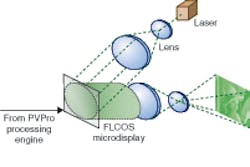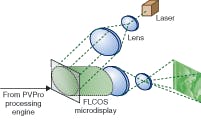HOLOGRAPHIC OPTICS: Miniature laser projector could open new markets
A new miniature laser-based projector based on a dynamic holographic optical element could help to open up new markets for mobile-device accessories. Engineers from Light Blue Optics (LBO; Cambridge, England) developed the matchbox-size system. In July 2006 the company received $2.5 million seed funding to accelerate product development for the device.
Light Blue Optics was founded in 2004 by a group of photonics specialists from Cambridge University. The company’s patented projection technology, dubbed PVPro, uses diode or diode-pumped solid-state (DPSS) lasers and the diffractive element, which allow focus-free operation, low power consumption, a robust design, and simple low-cost manufacture.
The heart of a PVPro projector system is a phase-modulating ferroelectric liquid-crystal-on-silicon (FLCOS) microdisplay on which a diffraction pattern is generated. This acts like a hologram. According to LBO, the hologram-generation algorithm allows holograms to be calculated in real time on inexpensive hardware. The algorithm produces patterns that diffract the incoming laser light to form a video image (see figure).There are no moving parts and the input and output optics are simple lens combinations with very few size constraints because the image generated from the hologram is small. No modulators are needed, as it is only necessary to modulate the laser beams according to scene brightness. This requires a laser-modulation frequency of approximately 1 kHz, which can be performed directly, and allows the laser-head and drive circuits to be positioned remotely. All this helps in the quest for further miniaturization. The demonstration system, which uses a green DPSS laser, is just 63 cm3 in volume. New developments include the demonstration of a three-color system that uses red and blue diode lasers, as well as the green DPSS, and in which the FLCOS microdisplay is time-sequentially illuminated by the three beams.
Because the image is formed by diffraction rather than by blocking any part of the input beam, all the light is used and the system is very efficient. The lenses after the FLCOS expand the small image generated by it, producing a throw angle of up to 114°. The expanded images are in focus at any distance from the projector, eliminating the need for a focus control. There is no requirement for the projection surface to be flat because the hologram algorithm can be easily modified to predistort the image for projection onto curved surfaces. Furthermore, because the FLCOS microdisplay directly controls the incident optical wavefront, the system is able to correct for optical aberrations by suitable calculation of the algorithms. For example, the system can correct for even highly nonuniform input laser-beam profiles.
“Our vision is to make it simple for people to share photos with their friends and to comfortably view mobile TV and music videos from their mobile devices,” says Edward Buckley, cofounder of the company, who also notes that stand-alone projectors, game consoles, and head-up displays are potential applications. “We plan to manufacture and supply projection subsystems (light engines) to our customers, who will then build these into complete end-user products.”
His company expects the market for miniature projectors capable of displaying large, high-resolution video images to explode in the next five years as mobile-device manufacturers look for ways to overcome the limitations of current small screens and unleash the large and growing quantity of multimedia content trapped inside.

